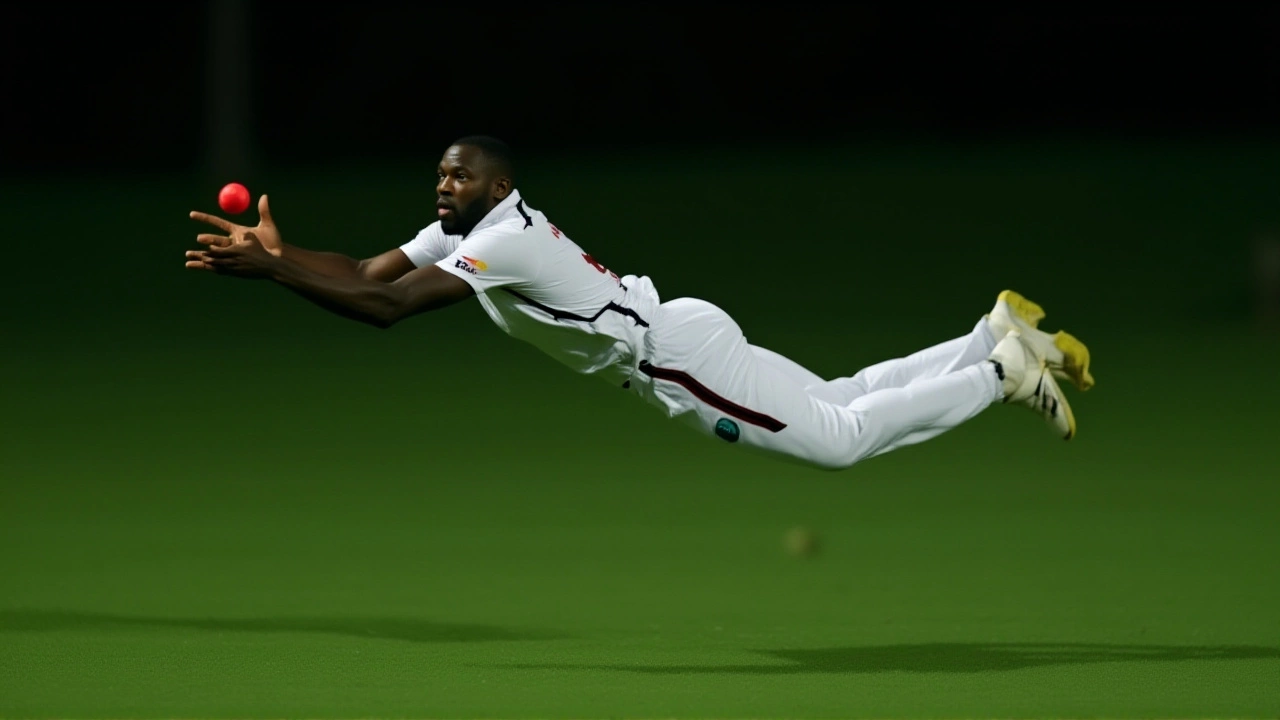When Anderson Phillip, a 28‑year‑old right‑arm fast bowler for Cricket West Indies, leapt at mid‑off and hauled in a spectacular catch to dismiss Australian opener Travis Head on July 12, 2025, the first day of the third Test in the Caribbean, the drama instantly lifted the spirits of a West Indian crowd of about 20,000 at Sabina Park Cricket Stadium. The dismissal came in the 65th over of a day‑night encounter that has already seen Australia bowled out for a modest 225, a score that reflects the challenging pink‑ball conditions and a West Indian attack that has surged up the ICC Test rankings.
Series backdrop and why the third Test matters
The three‑match series began in January with a rain‑spattered draw at Sir Vivian Richards Stadium in Antigua, followed by a decisive win for Australia at Queen's Park Oval on February 8, 2025, where they chased down a modest target with eight wickets to spare. After that victory, the Aussies carried a 1‑0 lead and a bruising defeat in the World Test Championship final to South Africa on June 29, 2025, weighed heavily on captain Pat Cummins and his side.
For the West Indies, skipper Kraigg Brathwaite has been eager to prove that the team’s climb from ninth to sixth in the ICC rankings, achieved between January 2024 and July 2025, isn’t a fluke. The day‑night format, introduced to the series in 2025, adds a new tactical layer – the pink Kookaburra ball behaves differently under lights, rewarding bowlers who can swing and seam under pressure.
The dive that made headlines
At 14:30 local time, West Indian off‑spinner Justin Greaves delivered a fuller ball that Head mis‑timed, sending the leather looping high toward mid‑off. Phillip, who had been fielding at the boundary, sprinted to his right, leapt fully extended, and managed to keep his elbow off the grass while securing the ball. The commentator on the official Windies Cricket YouTube channel, at timestamp 00:00:43, shouted, “Great effort. Great catch Anderson Phillip. And it had to be a fast bowler to do it. Great athleticism.” A fellow pundit added, “We fast bowlers are proud of that effort from a Anderson Phillip… what an impact he’s made.”
The catch not only dismissed Head – who has 31 Test centuries and averages 41.2 – but also shifted momentum. Australia, already under pressure, lost a key top‑order batsman and eventually fell short of par, finishing at 225 all out. The wicket sparked a brief revival for the Windies, who responded with a 347‑run partnership between Kraigg Brathwaite and Jermaine Blackwood later in the day.
Reactions from the cricketing world
Social media lit up with clips of the catch, drawing comparisons to Jonty Rhodes’ 1992 World Cup run‑out of Inzamam‑ul‑Haq and Steve Waugh’s 1999 one‑handed grab at the SCG. Former Australian great Ricky Ponting tweeted, “That’s the kind of fielding that turns matches. Hats off to Phillip.” West Indies coach Stuart Law said in a post‑match interview, “We’ve always believed fielding wins games. Phillip’s catch is a textbook example of why every player must be a fielder.”

Impact on the series and rankings
Statistically, the catch contributed to a 12‑run swing in the expected runs column, according to an analysis by ESPN Cricinfo. With Australia’s first‑innings total now clearly below par, the West Indies have an opening to bowl them out cheaply again in the second innings. If they can enforce a follow‑on, the Test could swing the series back to 1‑1, setting up a decisive finale at the same venue.
Beyond the immediate series, the catch underscores the resurgence of West Indian fielding standards, an area that has lagged since the early 2000s. Cricket West Indies’ performance director, Tony Coetzee, noted, “Our fielding drills have become more intensive, and Phillip’s athleticism is a testament to that investment.” The ICC’s upcoming review of the day‑night format may also take into account how fielding brilliance can offset batting advantages under lights.
What’s next for the teams?
The fourth day, scheduled for July 13, will see Australia’s bowlers – notably pacer Pat Cummins and spinner Nathan Lyon – attempt to restrict the Windies’ lead. If the West Indies post a total above 400, Australia will need a solid partnership to stay alive, making Phillip’s catch even more crucial.
Looking ahead, the series concludes on July 15, and both boards have hinted at a possible T20I tri‑series involving South Africa later in the year. For now, the Kingston crowd will remember Phillip’s athleticism as a highlight of what could become a historic Caribbean comeback.
Frequently Asked Questions
How did Anderson Phillip’s catch change the momentum of the match?
The dismissal removed Australia’s experienced opener, Travis Head, at a critical 65th‑over juncture. With Australia already under 230, the wicket intensified pressure, leading to a collapse that left them 225 all out. The catch also boosted West Indian morale, sparking a 347‑run partnership later in the day.
What is the significance of the day‑night format in this Test?
The pink ball behaves differently under lights, offering seamers more swing late in the day. Both teams adjusted line‑up strategies, with West Indies relying on fast bowlers like Phillip and Australia on pacer Pat Cummins to exploit twilight conditions.
Which players are expected to be key in the remaining days?
For the Windies, bowler Anderson Phillip and captain Kraigg Brathwaite will lead the attack, while Jermaine Blackwood’s middle‑order resilience remains vital. Australia will look to Pat Cummins for breakthroughs and openers David Warner and Aaron Finch to rebuild the innings.
How does this catch compare to historic fielding moments?
Commentators have likened it to Jonty Rhodes’ 1992 World Cup run‑out and Steve Waugh’s 1999 one‑handed catch. While not a run‑out, the full‑extension dive at mid‑off mirrors the athleticism of those famed moments and is being hailed as one of the best fielding plays in modern Test cricket.
What are the implications for West Indies’ ICC ranking?
If the Windies win the series, they could climb to fifth place in the ICC Test rankings, reinforcing their recent rise from ninth to sixth. A series victory would also boost confidence ahead of upcoming limited‑overs tournaments.

